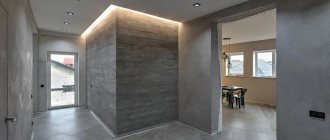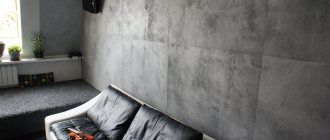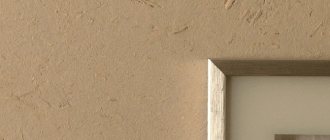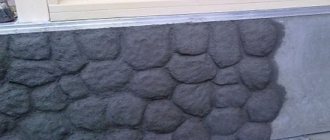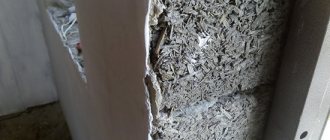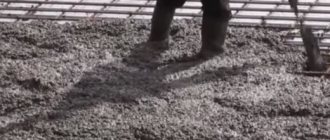Decorative plaster compositions with imitation of various surfaces are not only a building material, but also modern technologies. One of the most common types of finishing of interiors and even facades is decorative plaster for concrete. The article outlines options for stylizing the surface as concrete, a description of mixtures and additional components, and the basics of the technological process. Knowledge of the characteristics of the material and its application technologies will help to properly organize and control the finishing process.
Proper finishing of the wall “like concrete” looks very modern Source oikos.by
Decorating the surface for concrete
Plaster that imitates the surface of concrete has become a popular type of decoration for rooms in the minimalist style. Walls with a “concrete effect” look durable, solid, monumental, even if they are built from plasterboard.
Users are attracted not only by the illusion of strength and reliability, but also by the minimalism of appearance. Plastered in this way, the wall imitates the surface before the renovation began. But when looking at her, there is no feeling of incompleteness.
Decorative plaster for concrete in the interior in this style is usually performed in rooms with a simplified, at first glance, general design.
Types of material, their characteristics
The advantage of textured plaster for concrete is its variety. The mixtures are different in the content of ingredients, purpose, color scheme, and structure. In terms of composition/application, the following options exist.
- Gypsum, gypsum-lime mortars. Mainly internal finishing material before the decorative layer. It is white in color, so its cladding becomes simpler and is used to hide small flaws in the “base”.
- Mixtures based on sand and concrete. They can level out more serious defects and wall relief. Manufacturers produce material with additives, which adjust the characteristics of the finished product. The texture of sand-concrete mortars can be fine-, medium-, or coarse-grained. The material is for external use; it is used for exterior finishing and plastering of basements. When the plaster has a structure with a wide fractional composition, its application by hand is difficult. Larger items may simply fall out.
- "Warm" mixtures. They are available in dry form. The base contains light porous components instead of sand. These include granules of “expanded” vermiculite, foamed polystyrene, perlite, and foam glass balls. Fillers dominate in volume and provide the material with a high thermal insulation coefficient. It is used as an addition to wall insulation. Thanks to its grainy texture, it also acts as decoration. Suitable for interior and exterior cladding.
- Solutions with special fillers. The function of additives is to improve the technical characteristics of the suspension. They are waterproof, aimed at increasing heat or sound insulation.
- Material with decorative effects. Its properties allow it to be used for finishing. No additional design is required on top of it.
Products are manufactured on the basis of microconcrete or microcement.
Characteristics of microconcrete: good plasticity of the material; high adhesion; resistance to sudden changes in temperature; resistance to humidity, chemicals, synthetic products can be used to care for the coating; not susceptible to mechanical damage; the surface does not absorb odors; wear resistance.
Characteristics of microcement decorative for concrete: use as a finishing finish or as a coating before facing with another material; the composition fits well under different finishes, creating an impenetrable layer; the coating has a high density; moisture resistance; resistance to mechanical stress.
For the beauty of the surface and to improve the performance characteristics, finished walls are coated with waxes and varnishes.
Matching style
A minimum of things, furniture, muted colors, and discreet decor are generally called high-tech style. Premises decorated in this way can be used as a club or restaurant, as a rock studio or creative workshop, as a formal office space or as the home of a person who understands and loves art.
But there are no strict rules for home design. Therefore, in some cases it is advisable to install a bright sofa in the room or decorate one of the walls with abundant living greenery or flowers. Lighting is important, because twilight in a home with “concrete” walls causes a negative mood.
Without good lighting, such a room will look gloomy Source zebra100.ru
It is recommended to design concrete-look walls in rooms with high ceilings, preferably in large areas. A large space with bright lighting is associated with the naturalness of the loft style.
How to correctly position sockets in a concrete wall
A separate question when interacting with a concrete wall is how to insert sockets correctly. You need to follow a few simple rules:
- The socket box must be installed flush with the finished wall.
- The socket box is level so that there are no problems later.
- The socket box holds tightly in the nest.
In addition, you need to understand the necessary socket boxes, preparation of holes, and so on. 70 mm in diameter is the most popular standard size of socket boxes. Most sockets and switches are available in these sizes. The depth of the socket box is the second important parameter. To install a regular socket, you can use a shallow frame, but it is better to buy a deeper socket and connect the cables inside without any problems.
To install a socket box in concrete you need:
- Mark the holes. To do this, it is better to attach the socket boxes to the wall and draw a level line. The distance between two adjacent socket boxes is at least 71 mm.
- Prepare the hole. The hole is drilled using a hammer drill with a diamond crown, which negatively affects the cost of the tool. A drill with a drill bit for concrete will cost less. As a result of gating, dust is formed that will cover the floor and ceiling of the home.
- Holes are made in the marked centers. The hole is prepared with a small margin. A diamond core bit or concrete drill is used.
- After drilling the holes, you need to deepen them a little, literally a few millimeters.
A hole is carefully drilled with a diamond crown; the crown needs to cool every few minutes. If the drill touches the metal fittings in the wall, it can quickly deteriorate. You can use a grinder to make small cuts, and then hollow out a hole for the socket boxes. The socket boxes are secured to the wall with alabaster or roband. If you mix two substances together, the resulting mixture will not harden quickly. The wells are cleaned of dust and then moistened with water. After this, apply a thick solution inside and coat the insides as much as possible, as well as the sockets themselves.
The socket boxes are secured to the wall with alabaster or roband.
Schemes for correct placement of socket boxes
The layout of cables, sockets and switches is marked on the wall with a pencil. The vertical and horizontal axes are marked in the middle. You need to remember the distance of 71 mm between adjacent socket boxes.
You need to remember the distance of 71 mm between adjacent socket boxes.
Composition of the plaster mixture
Manufacturers offer ready-made plaster mixtures in various versions. Conventionally, they can be divided into two groups: microcement and microconcrete. Both categories contain:
- Finely ground cement;
- Seeded sand of minimum fraction, cleared of impurities;
- Polymer additives that give the compositions specific properties.
In addition to the listed components, microconcrete contains mineral additives of a slightly larger fraction.
The ingredients are usually indicated on the packaging. The manufacturer's recommendations, rules for preparing the surface, mixing the mixture and applying plaster are also written there.
Examples of wall textures “like concrete” Source o-remonte.com
See also: Catalog of companies that specialize in finishing materials.
How to make decorative plaster with a concrete effect with your own hands
To create a decorative coating on concrete, you can buy a building mixture or make it yourself. The plaster base is also easy to purchase or “knead”, for example, from cement (binder), sand (filler) and water. Standard proportions: 1:3, where one part of cement is three parts of sand. During mixing, the ratio can be adjusted, since the brands of “binder” and filler fractions may be different. It is permissible to introduce lime, gypsum, clay
Do not make the suspension too liquid; it is difficult to apply. Very thick material may begin to crack or fall off after drying.
The correct solution is medium in consistency. It should slide off the trowel in 8 seconds with a uniform, full mass.
Next, the purchased or prepared plaster needs to be converted “to look like concrete.” The composition is cement or gypsum, mixed with putty mixture and dyes. The proportions of the components are selected experimentally. Alternative option: polyvinyl acetate glue in an amount of 200 ml, gypsum mixture - 5 kg, water 2.5-3 l.
You can make the solution using a concrete mixer or place the ingredients in a container for loading materials and mix with a drill with a mixer attachment.
Ready-made building mixtures are sold in stores. They are usually dry and need to be diluted. The instructions on the manufacturer's packaging will help you make the correct composition. The consistency is indicated there, the diluent is usually water. The packs have requirements for proportions that must be adhered to.
When studying the packaging, you need to carefully look at what work the material is intended for. Colors can be integrated into the composition of the plaster, made or purchased, if it is gray (without pigment).
Solutions may be toxic! On the Internet it is easy to find out additional features of the composition and rules for working with it. Stirring, tinting, and coating must be carried out in compliance with safety precautions.
Properties and advantages of plaster
In addition to its appearance, which can be combined with any materials in the interior, decorative plaster “concrete” has a number of positive characteristics. The list of advantageous properties that allow us to consider the material universal and accessible in use:
- does not respond even to significant changes in humidity and air temperature in the room;
- does not require regular care;
- the plaster layer performs the function of retaining heat in the room, allowing you to significantly reduce heating costs;
- does not exert additional load or other undesirable effects on the original surface;
- easy to paint with any composition;
- can be used for an extremely long time without changing properties;
- applied to any surface with a high degree of adhesion;
- does not require high-quality smoothing or grinding;
- allows the use of stencils and stamps;
- work on applying plaster does not require high professional training;
- the surface texture is selected at the user’s request;
- Surface shades can be varied by adding regular acrylic dyes.
The addition of dyes makes the plaster more beautiful Source beton-house.com
Principles of application
The originally implemented sloppy relief adds a special “zest” to the decoration of the room. The use of this building material makes it possible to recreate unique textures using various construction techniques. They are made in a wide shade palette of gray and other colors, which in turn increases the scope of application.
Microconcrete can be polished to perfect smoothness. The plasticity of the finished solution is quite high; it becomes possible to slowly create the relief, in agreement with the developed finishing solution. The long-lasting flexibility of the mass allows you to apply wall figures using polymer stencils.
Disadvantages of exclusive plaster options
Plaster has practically no disadvantages. In technological terms, some difficulties may be caused by the length of time the mixture hardens. But this indicator is not critical - it is somewhat worse from the economic side of the issue.
Creating exclusive interiors requires not only the cost of expensive raw materials, but also payment for design development and selection of individual mixture components.
Good design is far from the cheapest pleasure Source market.kz
What problems may arise when working with concrete?
This is a high-quality material, the construction of walls from which is labor-intensive, but the final result will last for many years. However, there are a number of problems that arise while working with the material.
- A common problem is that the surface breaks. Most often this occurs due to improper mixing of components.
- Too runny. The problem is too much water added during the creation of the material.
- Concrete bursts after a while. The fact is that during mixing, crushed stone of several fractions is used.
The problem is too much water added during the creation of the material.
Peculiarities
When choosing a composition, you should take into account the individual characteristics of not only the room being decorated, but also the concrete plaster itself in the interior:
- The structure of the plaster is porous and the surface is rough, this is caused by the content of mineral fillers and additives in it;
- The relief of the coating is achieved by sequentially applying several layers of the mixture;
- Preliminary preparation of the surface to be plastered consists of cleaning it from dust, dirt, and previous coatings;
- During work, you should use personal protective equipment, since the mixtures contain polymers that are harmful to health.
An example of combining plaster and other finishes Source connexionav.com
Examples of colors and textures
When choosing the color of the plaster, the style direction of the room’s design is taken into account:
- Provencal - soft pink, blue, creamy milky;
- eco - dark brown, olive, marsh;
- minimalism - black, gray, snow-white;
- high-tech - metallic gray, black, snow-white;
- baroque - pastel shades;
- pin-up - soft pink, warm yellow;
- classic - white, gray, chocolate;
- modern - beige, brown, dark blue, emerald;
- futurism - white, lemon, light green, turquoise, ultramarine;
- country - sand, soft yellow, terracotta, dark brown;
- loft - blue, orange, red, dark green.
Based on texture, materials are divided into the following types:
- Structural. The composition includes granules and fibers of different sizes that form a textured layer.
- Terrasite. The composition allows you to simulate mining rocks.
- Venetian. The composition includes marble chips, lime and polymer particles, plasticizers, and tint fillers. Venetian plaster is characterized by its structural uniformity and ensures the creation of a smooth surface. The coating allows you to create an imitation of onyx and marble.
- Marseille wax. The composition has a soft texture and becomes smooth after drying. It allows you to reproduce the imitation of stone, wood and sandstone. The filler is cellulose fibers. The material is used to create interiors in Provencal and country styles.
- Bark beetle The pattern is optimal for all types of decorative plaster with the addition of different sizes of granules. Fine-grained compounds are used for interior finishing. Depending on the application method, the furrows are placed horizontally and vertically.
- Sgraffito. Includes multiple layers of different colors with a design engraved on the outer layer. The ornament is engraved 5-6 hours after the mass is distributed.
- Craquelure. The product presents the effect of an aged surface. The composition is used for different types of bases. First, painting is done with acrylic dye. To achieve the aging effect, the paint is distributed in chaotic strokes. A translucent varnish is applied on top and left for 3-4 hours until dry.
- Latex plastic. The product allows you to reproduce a glossy surface simulating marble or other stone. The composition is characterized by moisture-resistant characteristics and increased elasticity.
- Wet silk. The composition is distinguished by mother-of-pearl particles, which make it possible to reproduce the shimmer of silk fabric. The material is optimal for finishing the kitchen, living room, hallway, and bedroom.
- Sea breeze. The texture is characterized by roughness, the presence of fine-grained sand and pearlescent chips in the structure. The surface reproduces the texture with patterns of waves, sand dunes, and shading.
Offers from the top 5 manufacturers
There are many manufacturers of decorative plaster, but only some of them are constantly engaged in monitoring and improving the quality of their products. As a rule, these are well-known manufacturers who value their reputation:
- Prof Decor . A company from Russia produces decorative building materials in a wide range. Suppliers of initial components for plaster mixtures have been selected for the company over the years - only the best cooperate with this manufacturer. The company is distinguished from other manufacturers by the widest selection of colors and shades of plaster.
- San Marco . Decorative mixtures from this manufacturer are purchased by users who are interested in increased strength, moisture resistance and other increased characteristics. Similar parameters are required for plastering surfaces in non-standard and extreme conditions. The variety and excellent quality of polymers in mixtures is the strong point of the Italian manufacturer.
- "Flex Concrete System" . Decorative concrete for walls under this brand is used for surfaces that have direct contact with moisture or are subject to frequent overheating and temperature changes. A distinctive feature of the company’s products is the exact imitation of natural materials.
Original finishing solution Source stroyres.net
Technology of applying plaster to the base surface
You can decorate walls to look like concrete without any difficulties if you adhere to the process technology.
Preparing the base for plastering
Before you start decorating the concrete walls with your own hands, you need to prepare them. First, the previous coating is removed. If plaster or wallpaper was used, they should be moistened with water using a spray bottle. When the liquid is absorbed, scrape it off with a spatula. Painted walls are more difficult to clean. You will need to buy a solvent and treat the base.
When removing paint, you need to “walk” especially carefully along the joints and potholes. Clean from dirt, dust and level with primer. You can ignore wall defects in the form of shells; they will serve as decor. The cracks and small chips will be filled with the solution.
You must not leave stains from soot, rust, mold, or greasy oil stains on the wall! They will show through the finishing layer! If the surface is in order, it is impregnated with concrete contact and allowed to dry.
Tools
When working with decorative concrete for walls, you will need tools and their equivalents. We have already mentioned a spatula and a sprayer during preparation, a concrete mixer or a drill with a mixer attachment - when “mixing” the plaster. For application, equipment must be selected depending on the technique and texture of the material. A trowel, spatula, and brush may be needed, depending on what structure is planned.
A long block with a smooth edge is suitable for marking the surface. It is easy for them to “cover” the plane.
With the spray technique, a broom is an effective tool. If “combed shading” is selected, use a metal brush made of thin wire. You can use kitchen brushes, a “1000 lines” brush, a steel trowel, special stencils, and polyurethane stamps.
For adjustments, use sandpaper. When covering with clear varnish or wax, brushes are used.
Practical recommendations
When using the material, it is advisable to be guided by practical rules compiled by masters based on experience and mistakes made:
- Rooms where all the walls are covered with decorative plaster do not look very good. Art-concrete plaster in the interior is in perfect harmony with all finishing materials. Therefore, as a contrast or to highlight a special zone in the room, it is allowed, and sometimes it is simply necessary, to use wood, glass, or metal. The shape and layout depend on the taste of the owner or the conditions of the project.
Combination of materials in decoration Source archilovers.com
- The choice of color combinations depends on individual preferences, but harmony is paramount.
- Ceilings can be plastered in the same way as walls, but the shades of the ceiling plaster should be lighter.
- Sharp contrasts in the interior with “concrete” walls are acceptable, but in very small proportions.
Proper use of contrast and accents makes the interior recognizable and original Source id.aviarydecor.com
- Decorative plaster is not intended for leveling the surface to be coated, sealing cracks, joints and potholes.
How to prepare your work surface
Dust is carefully removed from work surfaces.
Grease stains are removed using special solvents. The concrete base is cleaned using appropriate tools. To do this, attach a metal brush to the drill. A grinding wheel made of emery is fixed on the grinder. If deep cracks form on the surface, they are filled with a sand-cement mixture. Minor defects may be left. The plaster will fill them, leveling the canvas. Particular attention is paid to the priming process. All areas are carefully treated with a compound that will ensure maximum adhesion to art concrete. Another important mission of the primer is to reduce the level of water absorption of the base. Treated surfaces are left to dry completely. Art concrete is sold in the form of a creamy mass.
Advantages and disadvantages
Fashionable building materials make it possible to implement creative solutions using repair and finishing procedures. It is preferred by highly professional artists, qualified builders and equally novice specialists who have mastered finishing technology.
Decorative finishing for concrete has a lot of positive advantages:
- Simply and efficiently transferred to the walls.
- Plastered surfaces demonstrate the sophistication of the interior.
- Reduces costs for finishing work.
- Harmonious combination with diverse building materials.
- Provides deep texture.
- Stability to the influence of various natural factors.
- Expanded range of color solutions.
- Good performance: low thermal conductivity, noise reduction, create comfort and coziness in the room.
- High adhesion to a variety of surfaces. The paste mixture flows freely onto metal, concrete areas, brick and stone.
- Long service life.
- Regardless of the size of the applied layer, the hardened plaster mixture does not form a significant weight stress on the building structure.
- It does not require preparation of a homogeneous surface before application, since the relief conceals errors and compensates for convexities.
Important nuances that should be observed when constructing concrete walls
A number of features that you need to pay attention to when working with concrete walls:
- The formwork supports the entire perimeter of the walls.
- The height of one layer should not exceed 300 mm.
- Vibration is part of building foundation walls.
The formwork supports the entire perimeter of the walls.
Concrete walls will add a touch of originality to your home. The main thing is to decide in advance whether the walls will be made of natural material or the surfaces will be imitated. The costs of repairs and decoration depend on this.
Operating procedure.
First you need to remove the old coating from the wall. The existing plaster, which does not hold firmly and has already begun to crumble, can be cleaned off with a spatula, after first moistening the wall with water. Allow the water to soak into the plaster layer to soften it, after which the coating will easily come off if scraped. Particular care must be taken to remove any remaining plaster from cavities and joints.
If the wall was covered with wallpaper, they are removed in the same way. It is more difficult to remove old paint, but this job can be done. Buy a special compound that dissolves old paint at a hardware store or market. One small jar is enough for several square meters.
Important: the composition is toxic, so use gloves, a respirator and work in a well-ventilated area.
How to make the coating even more impressive?
You can coat the plaster with varnish, then it will look noble and unusual. There is also a special wax on sale - it is also suitable for finishing. If you want the wall to shine and shimmer in daylight or artificial light, cover it with plaster.
A very interesting option for decorating with plaster to imitate brick.
